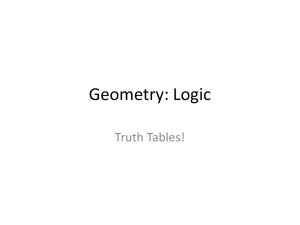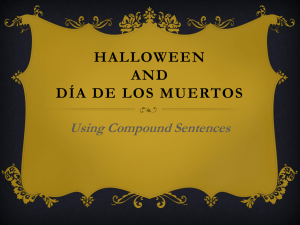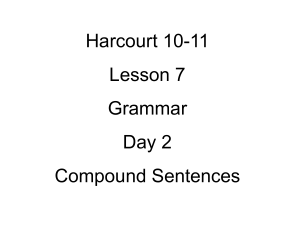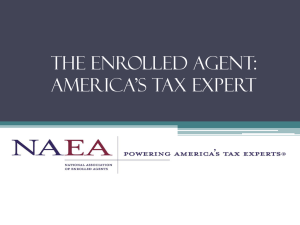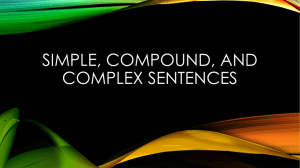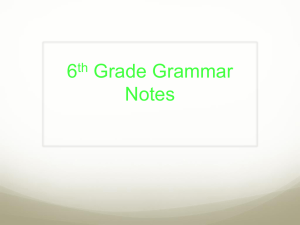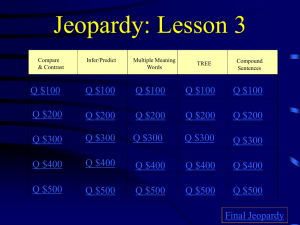Document
advertisement
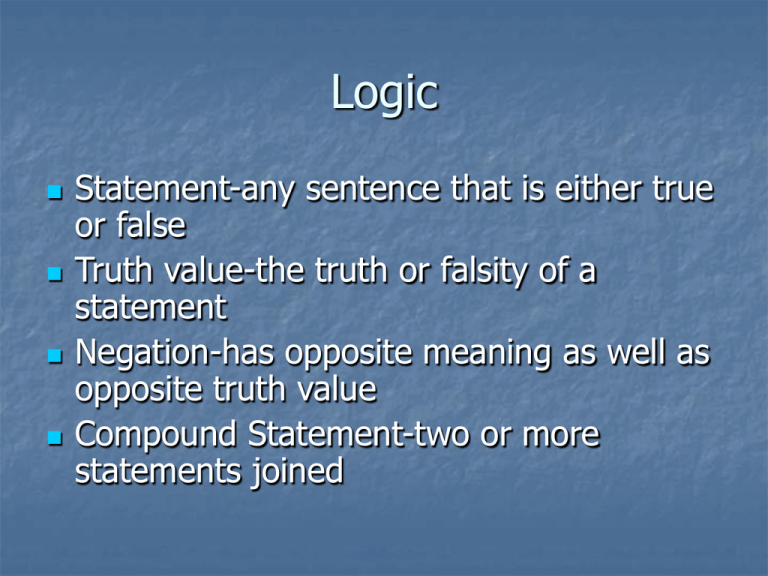
Logic Statement-any sentence that is either true or false Truth value-the truth or falsity of a statement Negation-has opposite meaning as well as opposite truth value Compound Statement-two or more statements joined Logic Conjunction (^) – compound statement formed by combing two or more statements with the word and Disjunction (v) - compound statement formed by combing two or more statements with the word or Use the following statements to write a compound statement for the conjunction p and q. Then find its truth value. p: One foot is 14 inches. q: September has 30 days. r: A plane is defined by three noncollinear points. Answer: One foot is 14 inches, and September has 30 days. p and q is false, because p is false and q is true. Use the following statements to write a compound statement for the conjunction . Then find its truth value. p: One foot is 14 inches. q: September has 30 days. r: A plane is defined by three noncollinear points. Answer: A plane is defined by three noncollinear points, and one foot is 14 inches. is false, because r is true and p is false. Use the following statements to write a compound statement for the conjunction . Then find its truth value. p: One foot is 14 inches. q: September has 30 days. r: A plane is defined by three noncollinear points. Answer: September does not have 30 days, and a plane is defined by three noncollinear points. is false because is false and r is true. Use the following statements to write a compound statement for the conjunction p r. Then find its truth value. p: One foot is 14 inches. q: September has 30 days. r: A plane is defined by three noncollinear points. Answer: A foot is not 14 inches, and a plane is defined by three noncollinear points. ~p r is true, because ~p is true and r is true. Use the following statements to write a compound statement for each conjunction. Then find its truth value. p: June is the sixth month of the year. q: A square has five sides. r: A turtle is a bird. a. p and r Answer: June is the sixth month of the year, and a turtle is a bird; false. b. Use the following statements to write a compound statement for each conjunction. Then find its truth value. p: June is the sixth month of the year. q: A square has five sides. r: A turtle is a bird. c. Answer: A square does not have five sides, and June is the sixth month of the year; true. d. Answer: A turtle is not a bird, and a square has five sides; false. Use the following statements to write a compound statement for the disjunction p or q. Then find its truth value. p: is proper notation for “line AB.” q: Centimeters are metric units. r: 9 is a prime number. Answer: is proper notation for “line AB,” or centimeters are metric units. p or q is true because q is true. It does not matter that p is false. Use the following statements to write a compound statement for the disjunction . Then find its truth value. p: is proper notation for “line AB.” q: Centimeters are metric units. r: 9 is a prime number. Answer: Centimeters are metric units, or 9 is a prime number. is true because q is true. It does not matter that r is false. Use the following statements to write a compound statement for each disjunction. Then find its truth value. p: 6 is an even number. q: A cow has 12 legs r: A triangle has 3 sides. a. p or r Answer: 6 is an even number, or a triangle as 3 sides; true. b. Answer: A cow does not have 12 legs, or a triangle does not have 3 sides; true. DANCING The Venn diagram shows the number of students enrolled in Monique’s Dance School for tap, jazz, and ballet classes. How many students are enrolled in all three classes? The students that are enrolled in all three classes are represented by the intersection of all three sets. Answer: There are 9 students enrolled in all three classes How many students are enrolled in tap or ballet? The students that are enrolled in tap or ballet are represented by the union of these two sets. Answer: There are 28 + 13 + 9 + 17 + 25 + 29 or 121 students enrolled in tap or ballet. How many students are enrolled in jazz and ballet and not tap? The students that are enrolled in jazz and ballet and not tap are represented by the intersection of jazz and ballet minus any students enrolled in tap. Answer: There are 25 + 9 – 9 or 25 students enrolled in jazz and ballet and not tap. PETS The Venn diagram shows the number of students at Manhattan School that have dogs, cats, and birds as household pets. a. How many students in Manhattan School have one of three types of pets? Answer: 311 b. How many students have dogs or cats? Answer: 280 c. How many students have dogs, cats, and birds as pets? Answer: 10 Construct a truth table for . Step 1 Make columns with the headings p, q, ~p, and ~p p q ~p ~p Construct a truth table for . Step 2 List the possible combinations of truth values for p and q. p q T T F F T F T F ~p ~p Construct a truth table for . Step 3 Use the truth values of p to determine the truth values of ~p. p q T T F F T F T F ~p F F T T ~p Construct a truth table for . Step 4 Use the truth values for ~p and q to write the truth values for ~p q. Answer: p q T T F F T F T F ~p F F T T ~p T F T T Construct a truth table for . Step 1 Make columns with the headings p, q, r, ~q, ~q r, and p (~q r). p q r ~q ~q r p (~q r) Construct a truth table for . Step 2 List the possible combinations of truth values for p, q, and r. p q r T T T T F T T T F T F F F T T F F T F T F F F F ~q ~q r p (~q r) Construct a truth table for . Step 3 Use the truth values of q to determine the truth values of ~q. p q r ~q T T T F T F T T T T F F T F F T F T T F F F T T F T F F F F F T ~q r p (~q r) Construct a truth table for . Step 4 Use the truth values for ~q and r to write the truth values for ~q r. p q r ~q ~q r T T T F F T F T T T T T F F F T F F T F F T T F F F F T T T F T F F F F F F T F p (~q r) Construct a truth table for . Step 5 Use the truth values for p and ~q r to write the truth values for p (~q r). Answer: p q r ~q ~q r p (~q r) T T T F F T T F T T T T T T F F F T T F F T F T F T T F F F F F T T T T F T F F F F F F F T F F Construct a truth table for (p q) ~r. Step 1 Make columns with the headings p, q, r, ~r, p q, and (p q) ~r. p q r ~r pq (p q) ~r Construct a truth table for (p q) ~r. Step 2 List the possible combinations of truth values for p, q, and r. p q r T T T T F T T T F T F F F T T F F T F T F F F F ~r pq (p q) ~r Construct a truth table for (p q) ~r. Step 3 Use the truth values of r to determine the truth values of ~r. p q r ~r T T T F T F T F T T F T T F F T F T T F F F T F F T F T F F F T pq (p q) ~r Construct a truth table for (p q) ~r. Step 4 Use the truth values for p and q to write the truth values for p q. p q r ~r pq T T T F T T F T F T T T F T T T F F T T F T T F T F F T F F F T F T T F F F T F (p q) ~r Construct a truth table for (p q) ~r. Step 5 Use the truth values for p q and ~r to write the truth values for (p q) ~r. Answer: p q r ~r pq (p q) ~r T T T F T T T F T F T F T T F T T T T F F T T F F T T F T T F F T F F F F T F T T F F F F T F F Construct a truth table for the following compound statement. a. Answer: p q r T T T T T T T F T F F F T T F T F T T F F F F F F T T F T T F F T F F F F T F F F F F F F F F F Construct a truth table for the following compound statement. b. Answer: p q r T T T T T T T F T T T T T T F T T T T F F T F F F T T T T T F F T F T F F T F T T T F F F F F F Construct a truth table for the following compound statement. c. Answer: p q r T T T T T T T F T T F T T T F T F T T F F T F T F T T T T T F F T F F F F T F T F T F F F F F F

